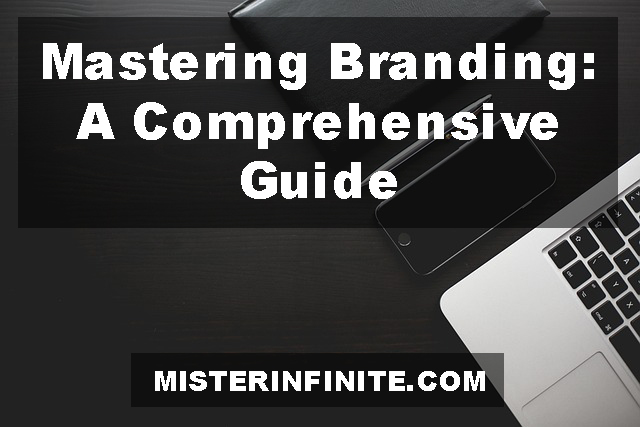Branding is an essential aspect of business success, distinguishing your company from competitors and establishing a strong connection with your audience.
Mastering branding involves:
- A deep understanding of your market
- A clear articulation of your brand values
- And consistent communication across all platforms.
This article will delve into the key strategies and elements required to master branding.
Understanding the Core of Branding
At its core, branding is the process of creating a unique identity for your business.
This identity encompasses your company’s:
- Name
- Logo
- Design
- Voice
- Reputation
- Customer experience
- And overall image.
A strong brand not only attracts customers but also builds loyalty and trust.
Key Elements of Branding
- Brand Identity: This includes tangible elements like your logo, color scheme, and typography. It’s the visual representation of your brand.
- Brand Voice: This defines how your brand communicates with the audience. It could be professional, friendly, authoritative, or humorous, depending on your target audience.
- Brand Values: These are the principles that guide your business operations and decision-making. They should resonate with your target audience and reflect what your company stands for.
- Brand Promise: This is the commitment you make to your customers, encapsulating the benefits and experiences they can expect from your brand.
Steps to Master Branding
1. Define Your Brand Strategy
A well-defined brand strategy is crucial.
It involves:
- Market Research: Understanding your target audience, their needs, preferences, and behaviors.
- Competitor Analysis: Identifying your competitors and analyzing their branding strategies to find your unique positioning.
- Brand Positioning: Determining how you want your brand to be perceived in the market. This involves finding a niche or a unique selling proposition (USP).
2. Develop a Strong Brand Identity
Creating a memorable brand identity involves:
- Logo Design: Your logo is the face of your brand. It should be simple, memorable, and reflective of your brand values.
- Visual Elements: Consistent use of colors, fonts, and design styles helps in creating a cohesive brand image.
- Brand Guidelines: Documenting your brand’s visual and communication standards ensures consistency across all platforms.
3. Craft Your Brand Voice
Your brand voice should reflect your brand’s personality and values.
To develop it:
- Define Your Tone: Decide how your brand will communicate with its audience. Will it be formal, casual, witty, or authoritative?
- Consistency is Key: Ensure that your brand voice remains consistent across all channels – from social media to customer service interactions.
4. Establish Your Brand Values
Brand values are integral to building trust and loyalty.
To establish them:
- Identify Core Principles: Determine the values that are most important to your brand.
- Communicate Them Clearly: Make sure your audience understands your values through your messaging and actions.
5. Deliver on Your Brand Promise
Your brand promise is a critical aspect of your brand’s reputation.
To uphold it:
- Consistency in Delivery: Ensure that every customer interaction reinforces your brand promise.
- Exceed Expectations: Aim to go beyond what you promise to create delighted customers who become brand advocates.
Building Brand Awareness
Once your brand is established, the next step is building brand awareness.
This involves making your brand known to a wider audience and establishing a strong presence in the market.
1. Utilize Social Media
Social media platforms are powerful tools for building brand awareness.
To leverage them effectively:
- Engage with Your Audience: Respond to comments, participate in discussions, and create content that encourages interaction.
- Consistent Posting: Regularly post content that is relevant and valuable to your audience.
2. Content Marketing
Creating and sharing high-quality content helps establish your brand as an authority in your industry.
This can include:
- Blog Posts: Share insights, tips, and industry news.
- Videos: Create engaging video content that tells your brand’s story or showcases your products.
- Infographics: Use visual content to simplify complex information and make it shareable.
3. Influencer Partnerships
Partnering with influencers can significantly boost your brand’s visibility.
To do this:
- Choose the Right Influencers: Collaborate with influencers whose audience aligns with your target market.
- Authentic Collaborations: Ensure that the partnership feels genuine and that the influencer truly believes in your brand.
4. Public Relations
Effective PR strategies can enhance your brand’s reputation and visibility.
This includes:
- Press Releases: Share newsworthy updates about your brand with the media.
- Media Interviews: Position yourself as a leader in your industry.
Measuring Branding Success
To ensure that your branding efforts are effective, it’s essential to measure and analyze your results.
Key metrics to track include:
- Brand Awareness: Social media metrics can help gauge how well your brand is known in the market.
- Customer Loyalty: Measure repeat purchases and customer retention rates.
- Engagement: Track how often your audience interacts with your brand on social media and other platforms.
- Sales Performance: Analyze how your branding efforts are impacting your sales and revenue growth.
Continuous Improvement
Branding is not a one-time effort but an ongoing process.
Regularly revisit your branding strategy to ensure it remains relevant and effective.
This involves:
- Feedback Loop: Continuously gather feedback from your customers and use it to improve your brand.
- Market Trends: Stay updated with market trends and adjust your branding strategy accordingly.
Conclusion
Mastering branding requires a strategic approach and consistent effort.
By:
- Defining a clear brand strategy
- Developing a strong brand identity
- Maintaining a consistent brand voice
- And building brand awareness
you can create a powerful brand that resonates with your audience and stands out in the market.
Remember, successful branding is about creating meaningful connections with your customers and delivering on your brand promise every single time.
Want to learn more?
You May Also Like:
The X Factor in Communication: Why Trust Outweighs Content
The Hidden Profit Strategy That Built McDonald’s Empire - And How You Can Use It
Swipe File Ammo: 1400+ Headlines, Calls To Action, Power Words, and Transitions To Help Increase Con...
Using AI for Business: The Right Way to Leverage Virtual Assistance
5 Traits Of Successful Business Owners
The Real Game of Sales: Energy and Attention Management
How to Build an Empire Without Anyone Knowing - The Forbidden Guide
HIDDEN MARKET EXPLOSION: The Shocking Truth About Untapped Wealth (And How to Access It NOW)
My name is Mister Infinite. I've written 600+ articles for people who want more out of life. Within this website you will find the motivation and action steps to live a better lifestyle.


